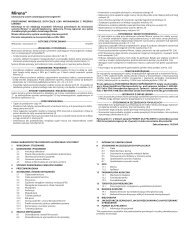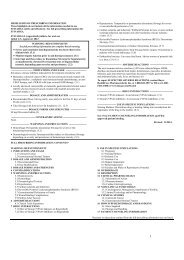Yaz - Bayer HealthCare
Yaz - Bayer HealthCare
Yaz - Bayer HealthCare
You also want an ePaper? Increase the reach of your titles
YUMPU automatically turns print PDFs into web optimized ePapers that Google loves.
For EE the terminal disposition phase half-life has been reported to be approximately 24 hours. EE is not excretedunchanged. EE is excreted in the urine and feces as glucuronide and sulfate conjugates and undergoes enterohepaticcirculation.Use in Specific PopulationsPediatric Use: Safety and efficacy of <strong>Yaz</strong> has been established in women of reproductive age. Efficacy is expected to bethe same for postpubertal adolescents under the age of 18 and for users 18 years and older. Use of this product beforemenarche is not indicated.Geriatric Use: <strong>Yaz</strong> has not been studied in postmenopausal women and is not indicated in this population.Race: No clinically significant difference was observed between the pharmacokinetics of DRSP or EE in Japanese versusCaucasian women (age 25–35) when 3 mg DRSP/0.02 mg EE was administered daily for 21 days. Other ethnic groupshave not been specifically studied.Renal Impairment: <strong>Yaz</strong> is contraindicated in patients with renal impairment.The effect of renal impairment on the pharmacokinetics of DRSP (3 mg daily for 14 days) and the effect of DRSP onserum potassium concentrations were investigated in three separate groups of female subjects (n=28, age 30–65). Allsubjects were on a low potassium diet. During the study, 7 subjects continued the use of potassium-sparing drugs for thetreatment of their underlying illness. On the 14th day (steady-state) of DRSP treatment, the serum DRSP concentrations inthe group with CLcr of 50–79 mL/min were comparable to those in the control group with CLcr ≥ 80 mL/min. The serumDRSP concentrations were on average 37% higher in the group with CLcr of 30–49 mL/min compared to those in thecontrol group. DRSP treatment did not show any clinically significant effect on serum potassium concentration. Althoughhyperkalemia was not observed in the study, in five of the seven subjects who continued use of potassium-sparing drugsduring the study, mean serum potassium concentrations increased by up to 0.33 mEq/L. [See Contraindications (4) andWarnings and Precautions (5.2).]Hepatic Impairment: <strong>Yaz</strong> is contraindicated in patients with hepatic disease.The mean exposure to DRSP in women with moderate liver impairment is approximately three times higher than theexposure in women with normal liver function. <strong>Yaz</strong> has not been studied in women with severe hepatic impairment. [SeeContraindications (4) and Warnings and Precautions (5.4).]Drug InteractionsConsult the labeling of all concurrently used drugs to obtain further information about interactions with oralcontraceptives or the potential for enzyme alterations.Effects of Other Drugs on Combined Oral ContraceptivesSubstances diminishing the efficacy of COCs: Drugs or herbal products that induce certain enzymes, including CYP3A4,may decrease the effectiveness of COCs or increase breakthrough bleeding.Substances increasing the plasma concentrations of COCs: Co-administration of atorvastatin and certain COCscontaining ethinyl estradiol increase AUC values for ethinyl estradiol by approximately 20%. Ascorbic acid andacetaminophen may increase plasma ethinyl estradiol concentrations, possibly by inhibition of conjugation. CYP3A4inhibitors such as itraconazole or ketoconazole may increase plasma hormone concentrations.HIV/HCV protease inhibitors and non-nucleoside reverse transcriptase inhibitors: Significant changes (increase ordecrease) in the plasma concentrations of estrogen and progestin have been noted in some cases of co-administration withHIV/HCV protease inhibitors or with non-nucleoside reverse transcriptase inhibitors.Antibiotics: There have been reports of pregnancy while taking hormonal contraceptives and antibiotics, but clinicalpharmacokinetic studies have not shown consistent effects of antibiotics on plasma concentrations of synthetic steroids.Effects of Combined Oral Contraceptives on Other DrugsCOCs containing ethinyl estradiol may inhibit the metabolism of other compounds. COCs have been shown tosignificantly decrease plasma concentrations of lamotrigine, likely due to induction of lamotrigine glucuronidation. Thismay reduce seizure control; therefore, dosage adjustments of lamotrigine may be necessary. Consult the labeling of theconcurrently-used drug to obtain further information about interactions with COCs or the potential for enzyme alterations.17






